Understanding Qualcomm's Snapdragon 810: Performance Preview
by Joshua Ho & Andrei Frumusanu on February 12, 2015 9:00 AM EST- Posted in
- SoCs
- Qualcomm
- Mobile
- Gobi
- Snapdragon 810
GPU Performance
Last but certainly not least, we have GPU performance. As we mentioned earlier, the Snapdragon 810 introduces Qualcomm's Adreno 430, the latest member of the Adreno 400 GPU family. Qualcomm's own performance estimates call for a 30% increase over Adreno 420, with a final GPU clock of 600MHz being identical to the Snapdragon 805's (Adreno 420) own GPU clock speed.
From an architectural standpoint Adreno continues to be something of a black box for us. Other than being a modern OpenGL ES 3.1/AEP design, we don't know too much about how the GPU is laid out, and Qualcomm's current legal battle with NVIDIA likely not helping matters. In any case, Qualcomm has indicated that Adreno 430 is not just a simple extension of Adreno 420, so we may be looking at an architectural change such as wider shader blocks.
For today's benchmarks, as we mentioned before we only had a limited amount of time with the Snapdragon 810 and had issues with BaseMark X. We've had to pare down our GPU benchmarks to just 3DMark 1.2 and GFXBench 3.0. Once we get final hardware in, we will be able to run a wider array of graphics benchmarks on Snapdragon 810.
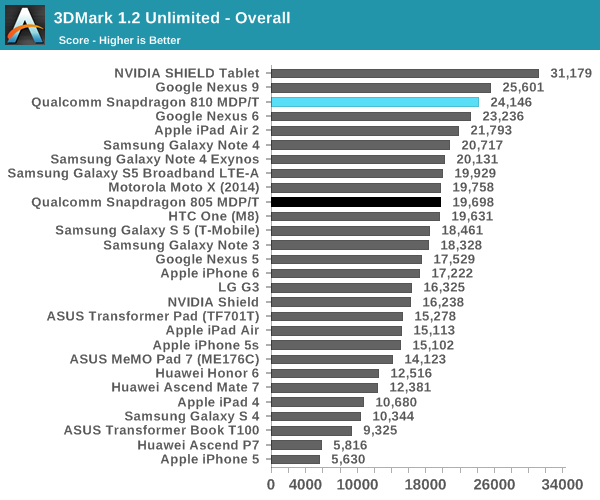
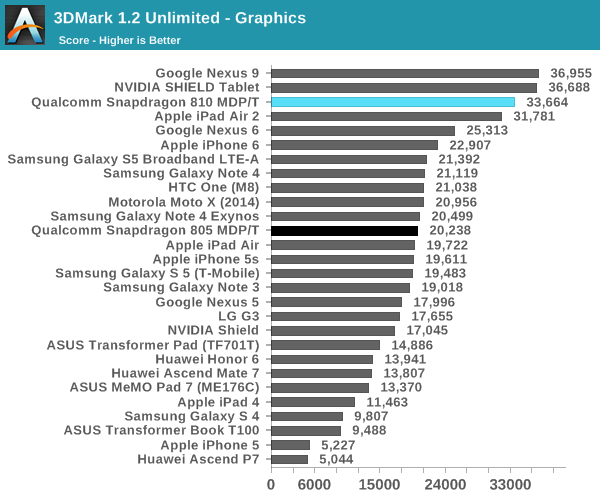
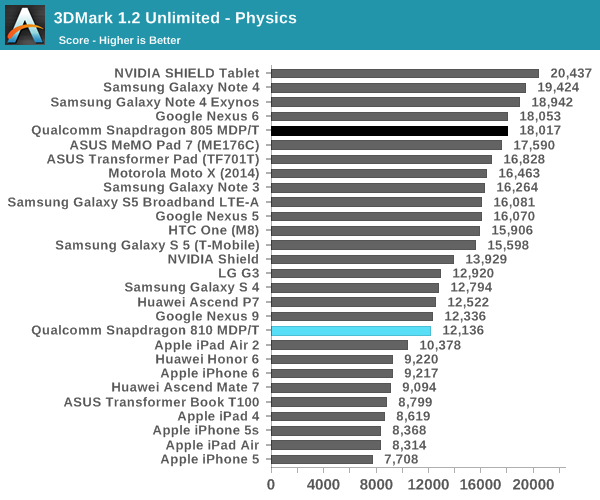
Starting off with 3DMark, compared to the Snapdragon 805 reference platform the actual graphics performance advantage is even greater than 30%, coming in at closer to 65%. However since drivers play a big role in this, a more recent 805 platform like the Nexus 6 may be a better comparison point, in which case the gains are 33%, just a hair over Qualcomm's own baseline performance estimate. We also find that Snapdragon 810 oddly struggles at physics performance here, underperforming Snapdragon 805 devices, something the Exynos 5433 didn't have trouble with. As a result overall performance is only slightly improved over the Nexus 6.
Continuing with GFXBench, we look at more pure GPU loads. One has to take note that the MDP/T employs a 4K screen resolution, and the on-screen results will likely suffer from that.

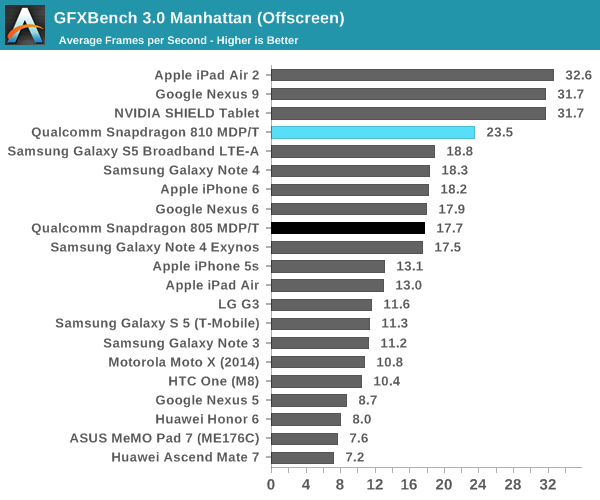
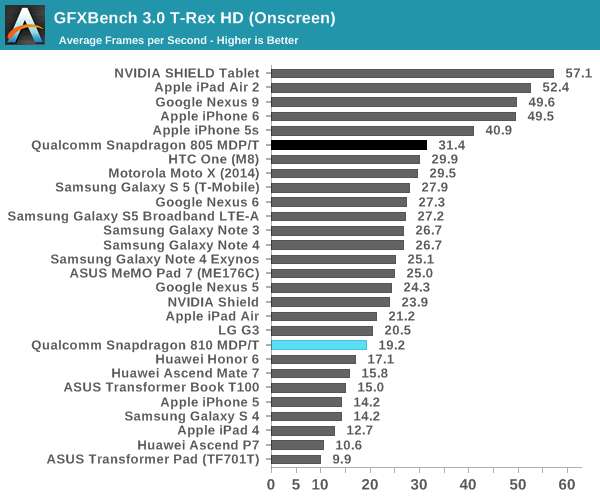
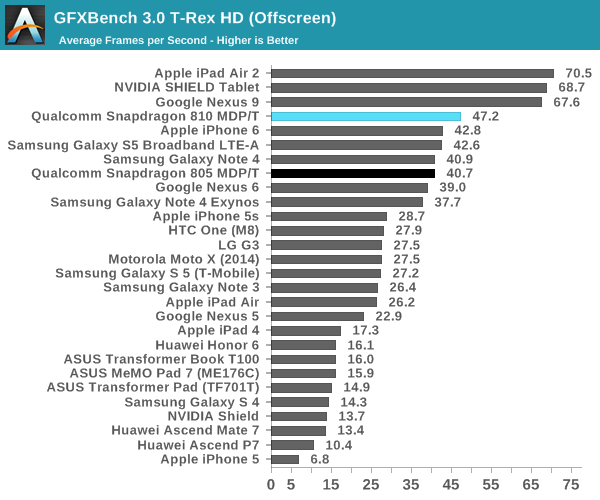
Under GFXBench 3.0's full rendering tests of Manhattan and T-Rex, the Snapdragon 810 continues to show considerable performance gains over the Snapdragon 805. Ignoring the onscreen results for now since the Snapdragon 810 reference platform runs at such a high resolution, offscreen results show the 810 outperforming the 805 by 33% in Manhattan and 16% in T-Rex. The former is again well in-line with Qualcomm's performance estimate, wile the older T-Rex benchmark doesn't show the same gains, possibly indicating that Adreno 430's biggest gains are going to come from shader-bound scenarios.
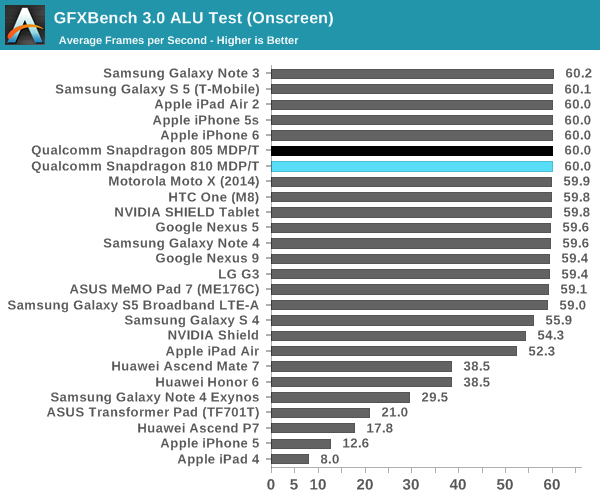
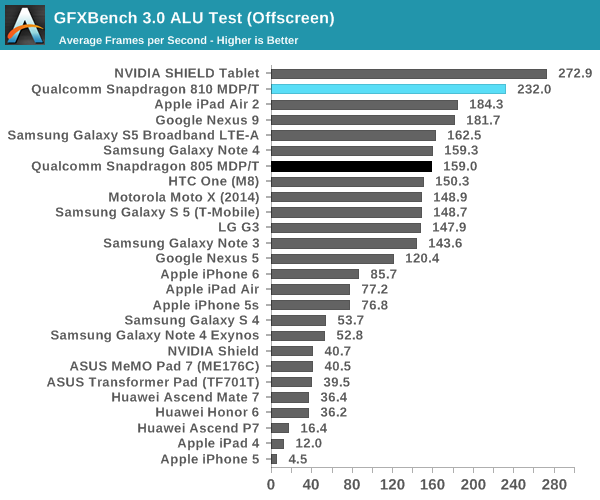

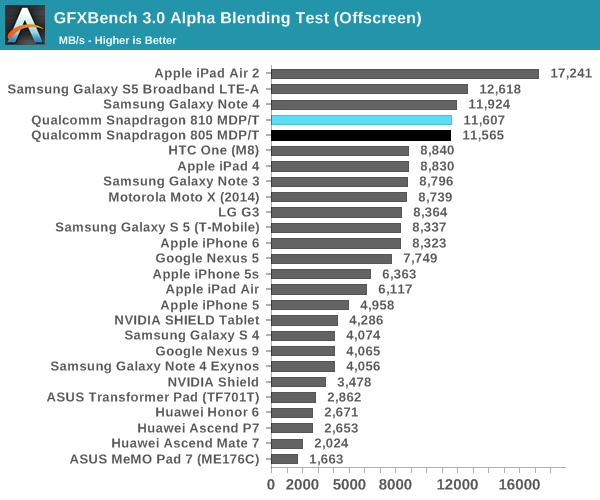
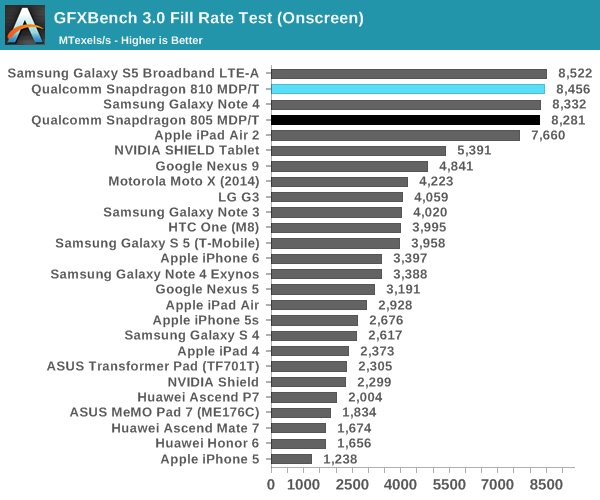
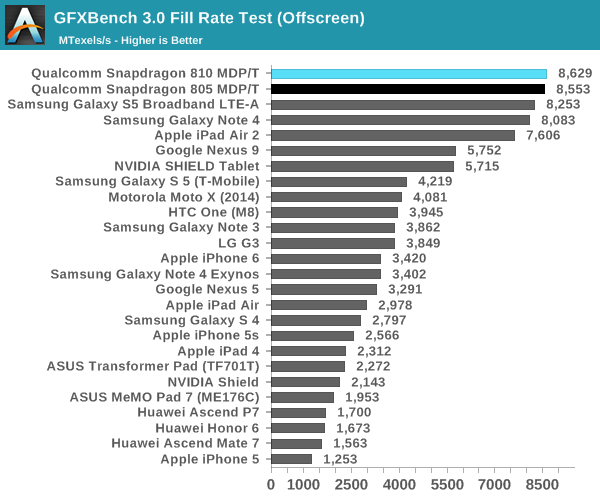
Meanwhile GFXBench's synthetic tests continue to put Adreno 430 and the Snapdragon 810 in a good light. ALU performance in particular is showing very large gains - 46% better than the Snapdragon 805 and Adreno 420 - while our blending and fillrate tests show almost no gain over Snapdragon 805. This adds further credence to our theory that Qualcomm has widened or otherwise improved Adreno's shader blocks for 430, as other elements of the GPU are not showing significant performance changes.
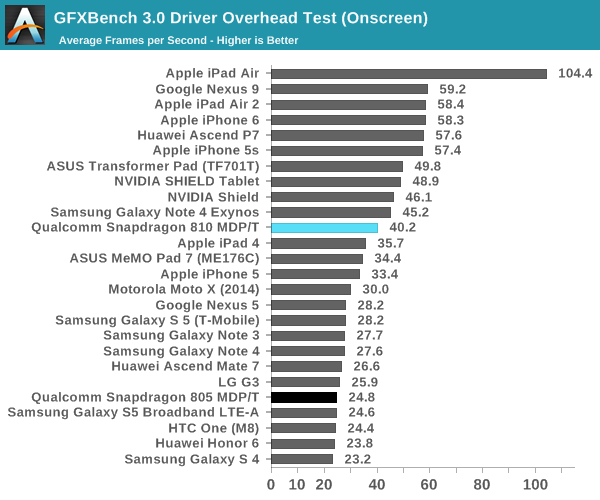
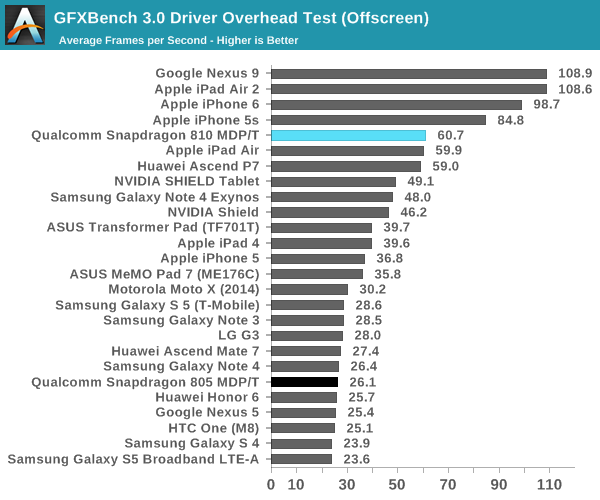
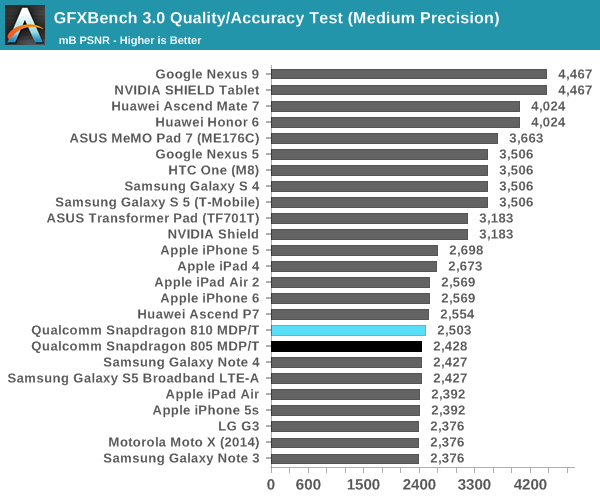

Finally, GFXBench's driver overhead and accuracy tests are more or less what we would expect for Snapdragon 810. In the case of driver overhead, a combination of newer drivers and a much faster CPU have reduced the CPU cost of driver overhead. Meanwhile with the underlying GPU architecture being unchanged, there are no material changes to quality/accuracy.
Overall then the performance gains for the Adreno 430 and Snapdragon 810 seem to be almost exclusively focused on shader performance, but in those cases where rendering workloads are shader bound, Qualcomm's 30% estimate is on the mark. Real-word performance gains meanwhile are going to depend on the nature of the workload; games and applications that are similarly shader-bound should see good performance gains, while anything that's bottlenecked by pixel throughput, texturing, or front-end performance will see much smaller gains. Thankfully for Qualcomm most high-end workloads are indeed shader bound, and this is especially the case when pushing high resolutions, as Qualcomm is trying to do with their 4K initiative for Snapdragon 810. However in the case of 4K, while Adreno 430 offers improved performance it's still slow enough that it's going to struggle to render any kind of decently complex content at that resolution.
As for Adreno 430 versus the competition, Qualcomm has narrowed much of the gap between themselves and NVIDIA/Apple, but they haven't closed it. Apple's Imagination GX6850 and NVIDIA's K1 GPUs continue to hold a performance advantage, particularly in GFXBench's Manhattan and T-Rex full rendering tests. Both Apple and NVIDIA invested significant die space in graphics, and while we don't know how much Qualcomm has invested in Adreno 430 with Snapdragon 810, it's safe to say right now that they would need to invest even more if they want to beat the graphics performance of NVIDIA and Apple's tablet SoCs.










119 Comments
View All Comments
PC Perv - Saturday, February 14, 2015 - link
Not an accurate description of the state of affairs. It is because Apple has the power over the carriers that other OEMs lack. I wish Congress can intervene in the situation and rein in on the carriers. That will not only benefit the U.S. consumers but also potentially influence the world market.Absolutely not "because Apple spend more money and Android OEMs do not want to spend money"
name99 - Friday, February 13, 2015 - link
"While there are multiple solutions to solving the power problem that comes with OoOE, ARM currently sees big.LITTLE as the best solution. "I can't help but think (based on all the evidence we've seen so far) that big.LITTLE is the VLIW of low energy CPUs. Just like VLIW would be totally awesome if we could only solve those pesky compiler issues (which are just out of reach, but maybe next year...), so big.LITTLE would be awesome if we could only solve those pesky scheduler issues (which will, likewise, maybe be solved next year...)
It's nice that QC claim they have a better scheduler; it would be even nicer if they were confident enough about it to provide actual power/energy NUMBERS...
TT Masterzz - Sunday, February 15, 2015 - link
Amazing article. Although to be frank I hardly understood the antenna part. It would be amazing if the authors at Anand Tech make an article explaining the RF system/modems/naming scheme and baseband processors in depth. Also an article explaining some terms like CPU pipeline length/branch mispredict would be amazing.Laststop311 - Friday, February 20, 2015 - link
All this is telling me is that it can barely beat last generation exynos. The exynos 7 most likely stomps this in performance which is why samsung had to go qwith it for all countries. People would be too mad if only S Korea got the super fast exynos 7 and every 1 else got the slower 810. Before snapdragon had the slioght performance edge but looks like exynos may finally be the better chip.That is untile qualcomm busts out their custom made 64 bit krait that just wasnt ready in time so they had to use standard arm cores to get 64 bit to market faster. Custom Kraint 64 whatever they call it it krait 500 or something will most likely beat exynos again.
Zingam - Wednesday, February 25, 2015 - link
Will these be DX12, OpenGL Next compatible, or will we have to wait for another 5 years for sufficient market penetration.Keermalec - Saturday, March 21, 2015 - link
So The 1-year old Nvidia K1 trounces the yet to arrive snapdragon 810...And yes, LTE is not integrated into the K1 in order for OEMS to have a choice between wifi or wifi+LTE tablet versions. Nvidia CAN integrate LTE in the SoC as they have done with the Tegra 4i. It was just sound business practice not to do so with the more powerful chip.
radeonex - Saturday, April 11, 2015 - link
I want to point out that for linear amplifier circuits, most of the transistors operation in the saturated region (they do not act as switches but rather voltage controlled current sources). The high electron mobility helps with trans-conductance and other characteristics especially in the context of combating short-channel effects (helps smaller devices). It also helps to reduce the minimum voltage drop required to keep the saturated transistors in the correct region of operation.Ning3n - Monday, July 27, 2015 - link
To give a "joe sixpack" review of the 810. I recently replaced my HTC M7 with an M9....As far as I've seen/noticed, the 810 (combined with the 430 GPU), is *ROUGHLY* 15-20% faster than the 600 series I've upgraded from.
Gaming performance (for a cellular device) is great! But, it took over an hour to encrypt just under 5Gb of mp3s, and 1.5Gb of pictures.
Hardly a "phenomenal" improvement.
b.akhil96 - Tuesday, June 21, 2016 - link
How do you categorize the loads ? max(avg,recent) policy when loads are categorized as peak or non peak . what would be an ideal policy to be applied on Moderate loads. (similar to max(avg,recent) )